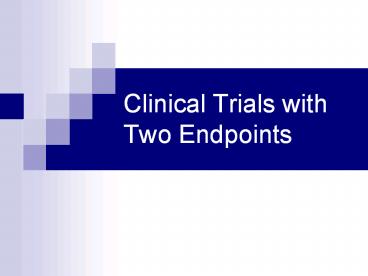Clinical Trials with Two Endpoints - PowerPoint PPT Presentation
1 / 20
Title:
Clinical Trials with Two Endpoints
Description:
Occurrence of Dementia. Insomnia: Time Till Sleep. Length of Continuous Sleep. Diet: Pounds lost ... There are better ways than Bonferroni that can consider when ... – PowerPoint PPT presentation
Number of Views:33
Avg rating:3.0/5.0
Title: Clinical Trials with Two Endpoints
1
Clinical Trials with Two Endpoints
2
EXAMPLES
HIV Vaccine Trial Outcome 1 Incidence of HIV
infection Outcome 2 Reaching Viral
Set-point Cardiovascular Stroke Heart
Attack Cognitive Evaluation of
Memory Occurrence of Dementia Insomnia Time
Till Sleep Length of Continuous Sleep Diet
Pounds lost MmHg BP Lowered
3
Difficulty Want an overall test that rejects
the null only 5 of the time. Somehow,
combine two endpoints. There are better ways than
Bonferroni that can consider when Modest effects
are seen in each outcome. Dealing with the
difficulty Combine Endpoints into a Composite
Endpoint . Here, you condense results into a
single outcome. May complication interpretation
of statistic (Burden of Illness Scores, total
time awake at night, lost 10 lbs or lowered BP
) Combine Tests. Perform a statistical test on
each endpoint separately, and then consider
results from both tests together. Combine
P-values.
4
ONE-SIDED TESTS Why? Believe treatment can only
be beneficial Only care if treatment can be
beneficial One Outcome Ho
T0 HA T gt 0 Reject
when Z1 gt a0.05
Two Outcomes H0 T1 0, T2 0 HA T 10,
T 20 (with one strict inequality) How do
you test this hypothesis?
5
EXAMPLE of a STUDY with TWO OUTCOMES DIET Outco
me 1 Weight Loss
Outcome 2 Blood Pressure Lower Wi Starting
Weight Final Weight
BPiStarting SBP Final SBP
6
Option 1 Simes Test
Reject H0 when max(Z1,Z2) gt kx or min(Z1,Z2) gt kn
7
Option 2 Fishers Test
Reject H0 when (Z1Z2) gt k
8
Option 3 Linear Combination of Z Statistics
Reject H0 when Z1 Z2 gt k
9
Options 4 - 6 Weighted Versions of Statistics
Reject H0 when w1Z1 w2Z2 gt k
When w1 is large, rejection is primarily based on
Z1
10
Ideal Test? Most Powerful?
HA E(Z1) ?1 E(Z2) ?2
( ?1, ?2)
Only one alternative
Reject Ho when Z1 ?1Z2 ?2gtk
11
Ideal Test? Most Powerful?
HA E(Z1) ?1 E(Z2) ?2
( ?1, ?2)
Only one alternative
Reject Ho when Z1 ?1Z2 ?2gtk
12
Ideal Test? Most Powerful?
(Z1,Z2)
( ?1, ?2)
Z1 ?1Z2 ?2
Reject Ho when Z1 ?1Z2 ?2gtk
13
Best test statistic under known
alternative Z1 ?1 Z2 ?2 Unknown (?1,?2)?
Estimate the parameters from the data
When there are no restrictions on the Parameter
space
However, by believing our treatment can only be
beneficial, we implicitly State ?1, ?2 0
14
Rejection Region for
15
Likelihood Ratio Test
Switch notation, return to variation of original
example 1) Assume subjects are paired. 2)
Let Xi1,Xi2 be the difference in weight and blood
pressure change for Pair i. TREATMENT WORK
µ1 E(X1) gt 0 and/or µ2 E(X2) gt 0
Density
LR
Just need to find the µ that maximizes the
denominator. And then can Use 2log(?) as the
likelihood ratio test.
16
Likelihood Ratio Test (Continued)
MLEs (assuming X1 and X2 are independent)
(skipping the algebra)
log
Always use LRT? --It is very difficult to
maximize µ when Xi1 and Xi2 are not
independent Use LRT for POC HIV Vaccine
Trial? --The Z statistics for incidence of viral
infection and reaching viral set-point are
independent.
17
Properties of Likelihood Ratio Test Combining
Most Powerful Rejection Regions
18
Properties of Likelihood Ratio Test Combining
Most Powerful Rejection Regions
19
Properties of Likelihood Ratio Test Combining
Most Powerful Rejection Regions
20
Uniformly Most Powerful Invariant Test (UMPI)
Notation
Ra(T) The rejection region that gives the most
powerful a-level test under the alternative
hypothesis, T (?1,?2). pa(T) The power of
the most powerful a-level test under the
alternative hypothesis, T (?1,?2),.
If we can write the rejection region as the union
of Ra(T) such that pa (T) is the same for
equivalent Ts, we will say that test has
composition invariance.
Question
When does composition invariance imply that the
test is Uniformly Most Powerful Invariant?
THE END































